Phase Field Simulations of Microstructures in Porous Ferromagnetic Shape Memory Alloy Ni2MnGa
Abstract
:1. Introduction
2. Simulation Methods
- (1)
- For simplicity, a sharp interface was introduced into the phase field parameter eta, the pore (air) phase and the alloy phase were separated by a sharp interface, and the phase field is non-evolving, and represents a static porous structure.
- (2)
- The defects, including point defects, dislocations, grain boundaries, and stacking faults are neglected in the current implementation.
- (3)
- The diffusion of the chemical composition, solute redistribution, and segregation during phase transformation are not considered.
- (4)
- The environmental temperature is static and homogenously distributed in the material.
3. Results and Discussion
- (i)
- 180-degree domain wall motion occurred, magnetization climbed quickly, but the martensite structure did not change, and there was no MFIS.
- (ii)
- The 90-degree domain wall began to move with martensite twin boundaries motion, attributed to the effect of the magnetoelastic coupling and material microstructure. The magnetization increased at a lower rate, but MFIS increased rapidly.
- (iii)
- The magnetization was fully saturated, and the martensite turned to a single-variant structure. The maximal MFIS was obtained by variant reorientation.
4. Conclusions
- (1)
- For homogeneously distributed pores, small pores at low porosity have a minor influence on the domain structure and martensite structure. With the increase in pore size and porosity, new martensite variants start to nucleate and grow at the pore surface, which leads to needle-like/lamellae microstructures. The magnetic domain walls are decoupled from the martensite twin boundary and result in a decrease in MFIS. The MFIS for alloys with circle-shaped pores decreased from 2.96% at a porosity of 1.2% to 0.036% when the porosity was increased to 44.2%.
- (2)
- The alignment of ellipse-shaped pores is very important for the MFIS of porous alloys. The elongated direction of ellipse pores oriented along the twin boundaries allows easier movement of twins and enhances the MFIS while maintaining the same porosity. For a sample with a pore aspect ratio of 1:6, the enhancement of MFIS reached a maximum value of up to 227%.
- (3)
- The pores can be considered as a kind of defect analog to micro-cracks, and lead to a significant stress concentration. The stress concentration point often stays at the location of twin boundaries or causes a twist of twin boundaries to the elastic energy of the system.
- (4)
- The recovery strain during the heating process was examined for the porous NiMnGa alloys. The recovery strain decreases steadily from 3.76% to 0.004% with increasing porosity from 1.2% to 44.1%.
- (5)
- For randomly distributed pore structures, the MFIS drops with the increase in porosity level. The MFIS of the alloys with randomly distributed pores is lower than that of the homogenously distributed pores. The MFIS is also associated with the distribution of pore architecture and related structures. For alloys with the same porosity, smaller or larger pore helps to maintain the optimized value of MFIS.
Author Contributions
Funding
Data Availability Statement
Conflicts of Interest
References
- Gebbia, J.F.; Castán, T.; Lloveras, P.; Porta, M.; Saxena, A.; Planes, A. Multiferroic and Related Hysteretic Behavior in Ferromagnetic Shape Memory Alloys. Phys. Status Solidi (b) 2017, 255, 1700327. [Google Scholar] [CrossRef]
- Zhang, X.; Qian, M. Ferromagnetic Shape Memory Alloys: Foams and Microwires. In Shape Memory Alloys—Fundamentals and Applications; IntechOpen: London, UK, 2017. [Google Scholar]
- Chernenko, V.A.; Besseghini, S. Ferromagnetic shape memory alloys: Scientific and applied aspects. Sens. Actuators A Phys. 2008, 142, 542–548. [Google Scholar] [CrossRef]
- Koyama, T. Phase-field modeling of microstructure evolutions in magnetic materials. Sci. Technol. Adv. Mater. 2008, 9, 013006. [Google Scholar] [CrossRef]
- Liu, G.D.; Liu, Z.H.; Dai, X.F.; Yu, S.Y.; Chen, J.L.; Wu, G.H. Investigation on ferromagnetic shape memory alloys. Sci. Technol. Adv. Mater. 2005, 6, 772–777. [Google Scholar] [CrossRef]
- Pons, J.; Cesari, E.; Seguí, C.; Masdeu, F.; Santamarta, R. Ferromagnetic shape memory alloys: Alternatives to Ni–Mn–Ga. Mater. Sci. Eng. A 2008, 481–482, 57–65. [Google Scholar] [CrossRef]
- Yu, G.-H.; Xu, Y.-L.; Liu, Z.-H.; Qiu, H.-M.; Zhu, Z.-Y.; Huang, X.-P.; Pan, L.-Q. Recent progress in Heusler-type magnetic shape memory alloys. Rare Met. 2015, 34, 527–539. [Google Scholar] [CrossRef]
- Faran, E.; Shilo, D. Ferromagnetic Shape Memory Alloys—Challenges, Applications, and Experimental Characterization. Exp. Tech. 2016, 40, 1005–1031. [Google Scholar] [CrossRef]
- Pushin, V.; Korolyov, A.; Kuranova, N.; Marchenkova, E.; Ustyugov, Y. New Metastable Baro- and Deformation-Induced Phases in Ferromagnetic Shape Memory Ni2MnGa-Based Alloys. Materials 2022, 15, 2277. [Google Scholar] [CrossRef]
- Huang, L.; Cong, D.; Wang, M.; Wang, Y. Coexisting Multiple Martensites in Ni57−xMn21+xGa22 Ferromagnetic Shape Memory Alloys: Crystal Structure and Phase Transition. Metals 2021, 11, 1534. [Google Scholar] [CrossRef]
- Chiu, W.-T.; Okuno, M.; Tahara, M.; Inamura, T.; Hosoda, H. Investigations of the Crystallographic Orientation on the Martensite Variant Reorientation of the Single-Crystal Ni-Mn-Ga Cube and Its Composites for Actuator Applications. Actuators 2023, 12, 211. [Google Scholar] [CrossRef]
- Xue, L.; Mu, H.; Sun, Y. Micromechanical model for the ferromagnetic shape memory alloy-epoxy resin composite considering variant reorientation and magneto-mechanical coupling. J. Mech. Behav. Biomed. Mater. 2021, 117, 104396. [Google Scholar] [CrossRef]
- Panico, M.; Brinson, L.C. Computational modeling of porous shape memory alloys. Int. J. Solids Struct. 2008, 45, 5613–5626. [Google Scholar] [CrossRef]
- Ke, C.; Cao, S.; Ma, X.; Huang, P.; Zhang, X. Phase field simulation of effects of pores on b2–r phase transformation in niti shape memory alloy. Acta Metall. Sin. 2013, 49, 115. [Google Scholar] [CrossRef]
- Dunand, D.C.; Mullner, P. Size effects on magnetic actuation in Ni-Mn-Ga shape-memory alloys. Adv. Mater. 2011, 23, 216–232. [Google Scholar] [CrossRef] [PubMed]
- Chmielus, M.; Zhang, X.X.; Witherspoon, C.; Dunand, D.C.; Mullner, P. Giant magnetic-field-induced strains in polycrystalline Ni-Mn-Ga foams. Nat. Mater. 2009, 8, 863–866. [Google Scholar] [CrossRef]
- Zhang, X.X.; Witherspoon, C.; Müllner, P.; Dunand, D.C. Effect of pore architecture on magnetic-field-induced strain in polycrystalline Ni–Mn–Ga. Acta Mater. 2011, 59, 2229–2239. [Google Scholar] [CrossRef]
- Wang, K.; Hou, R.; Xuan, J.; Li, X.; Zhu, J. Shape memory effect and superelasticity of Ni50Mn30Ga20 porous alloy prepared by imitation casting method. Intermetallics 2022, 149, 107668. [Google Scholar] [CrossRef]
- Imran, M.; Zhang, X. Ferromagnetic shape memory Ni-Fe-Ga alloy foams for elastocaloric cooling. J. Phys. D Appl. Phys. 2020, 53, 245503. [Google Scholar] [CrossRef]
- Song, W.; Tang, X.; Liu, B. A micromechanical constitutive model for porous ferromagnetic shape memory alloys under magneto-mechanical coupling. J. Mater. Res. 2023, 38, 2349–2358. [Google Scholar] [CrossRef]
- Wu, P.; Liang, Y. Enhanced Reversible Magnetic-Field-Induced Strain in Ni-Mn-Ga Alloy. Metals 2021, 11, 2017. [Google Scholar] [CrossRef]
- Jin, Y.M. Effects of twin boundary mobility on domain microstructure evolution in magnetic shape memory alloys: Phase field simulation. Appl. Phys. Lett. 2009, 94, 3081011. [Google Scholar] [CrossRef]
- Peng, Q.; Huang, J.; Chen, M.; Sun, Q. Phase-field simulation of magnetic hysteresis and mechanically induced remanent magnetization rotation in Ni-Mn-Ga ferromagnetic shape memory alloy. Scr. Mater. 2017, 127, 49–53. [Google Scholar] [CrossRef]
- Wu, H.-H.; Ke, Y.; Zhu, J.; Wu, Z.; Wang, X.-L. Effects of magnetic frequency and the coupled magnetic-mechanical loading on a ferromagnetic shape memory alloy. J. Phys. D Appl. Phys. 2021, 54, 155301. [Google Scholar] [CrossRef]
- Xie, X. Phase field-finite element analysis of magnetic-induced deformation in ferromagnetic shape memory alloy. Comput. Mater. Sci. 2022, 210, 111454. [Google Scholar] [CrossRef]
- Xie, C.; Zhao, H.; Du, L.; Du, H.; Wu, P. Enhanced ferroelectricity for nanoporous barium titanate: A phase-field prediction. Philos. Mag. Lett. 2021, 101, 341–352. [Google Scholar] [CrossRef]
- Ansari, T.Q.; Huang, H.; Shi, S.-Q. Phase field modeling for the morphological and microstructural evolution of metallic materials under environmental attack. Npj Comput. Mater. 2021, 7, 143. [Google Scholar] [CrossRef]
- Lookman, T.; Shenoy, S.R.; Rasmussen, K.Ø.; Saxena, A.; Bishop, A.R. Ferroelastic dynamics and strain compatibility. Phys. Rev. B 2003, 67, 024114. [Google Scholar] [CrossRef]
- Zhang, J.X.; Chen, L.Q. Phase-field microelasticity theory and micromagnetic simulations of domain structures in giant magnetostrictive materials. Acta Mater. 2005, 53, 2845–2855. [Google Scholar] [CrossRef]
- Chen, L.Q.; Shen, J. Applications of semi-implicit Fourier-spectral method to phase field equations. Comput. Phys. Commun. 1998, 108, 147–158. [Google Scholar] [CrossRef]
- Zhang, J.X.; Chen, L.Q. Phase-field model for ferromagnetic shape-memory alloys. Philos. Mag. Lett. 2005, 85, 533–541. [Google Scholar] [CrossRef]
- Tickle, R.; James, R.D. Magnetic and magnetomechanical properties of Ni2MnGa. J. Magn. Magn. Mater. 1999, 195, 627–638. [Google Scholar] [CrossRef]
- Paul, D.I.; Marquiss, J.; Quattrochi, D. Theory of magnetization: Twin boundary interaction in ferromagnetic shape memory alloys. J. Appl. Phys. 2003, 93, 4561–4565. [Google Scholar] [CrossRef]
- Wang, C.; Wang, H.; Huang, T.; Xue, X.; Qiu, F.; Jiang, Q. Generalized-stacking-fault energy and twin-boundary energy of hexagonal close-packed Au: A first-principles calculation. Sci. Rep. 2015, 5, srep10213. [Google Scholar] [CrossRef]
- Dai, L.; Cullen, J.; Cui, J.; Wuttig, M.R. Elasticity Study in Ferromagnetic Shape Memory Alloys. MRS Proc. 2003, 785, 221–2210. [Google Scholar] [CrossRef]
- Glavatska, N.; Mogilniy, G.; Glavatsky, I.; Danilkin, S.; Hohlwein, D.; Beskrovnij, A.; Lindroos, V.K. Temperature dependence of martensite structure and its effect on magnetic field induced strain in Ni2MnGa magnetic shape memory alloys. J. Phys. IV 2003, 112, 963–967. [Google Scholar] [CrossRef]
- Wong, B. Color blindness. Nat. Methods 2011, 8, 441. [Google Scholar] [CrossRef]
- Averkin, A.I.; Krymov, V.M.; Guzilova, L.I.; Timashov, R.B.; Soldatov, A.V.; Nikolaev, V.I. Reactive Stresses in Ni49Fe18Ga27Co6 Shape-Memory-Alloy Single Crystals. Tech. Phys. Lett. 2018, 44, 181–183. [Google Scholar] [CrossRef]
- Belyakov, V.N. The effect of generating reactive stresses in the spring elements of titanium nickelide. IOP Conf. Ser. Mater. Sci. Eng. 2019, 656, 012009. [Google Scholar] [CrossRef]
- Conti, S.; Lenz, M.; Rumpf, M.; Verhülsdonk, J.; Zwicknagl, B. Geometry of Needle-Like Microstructures in Shape-Memory Alloys. Shape Mem. Superelasticity 2023. [Google Scholar] [CrossRef]
- Boonyongmaneerat, Y.; Chmielus, M.; Dunand, D.C.; Müllner, P. Increasing Magnetoplasticity in Polycrystalline Ni-Mn-Ga by Reducing Internal Constraints through Porosity. Phys. Rev. Lett. 2007, 99, 247201. [Google Scholar] [CrossRef]
- Witherspoon, C.; Zheng, P.; Chmielus, M.; Dunand, D.C.; Müllner, P. Effect of porosity on the magneto-mechanical behavior of polycrystalline magnetic shape-memory Ni–Mn–Ga foams. Acta Mater. 2015, 92, 64–71. [Google Scholar] [CrossRef]
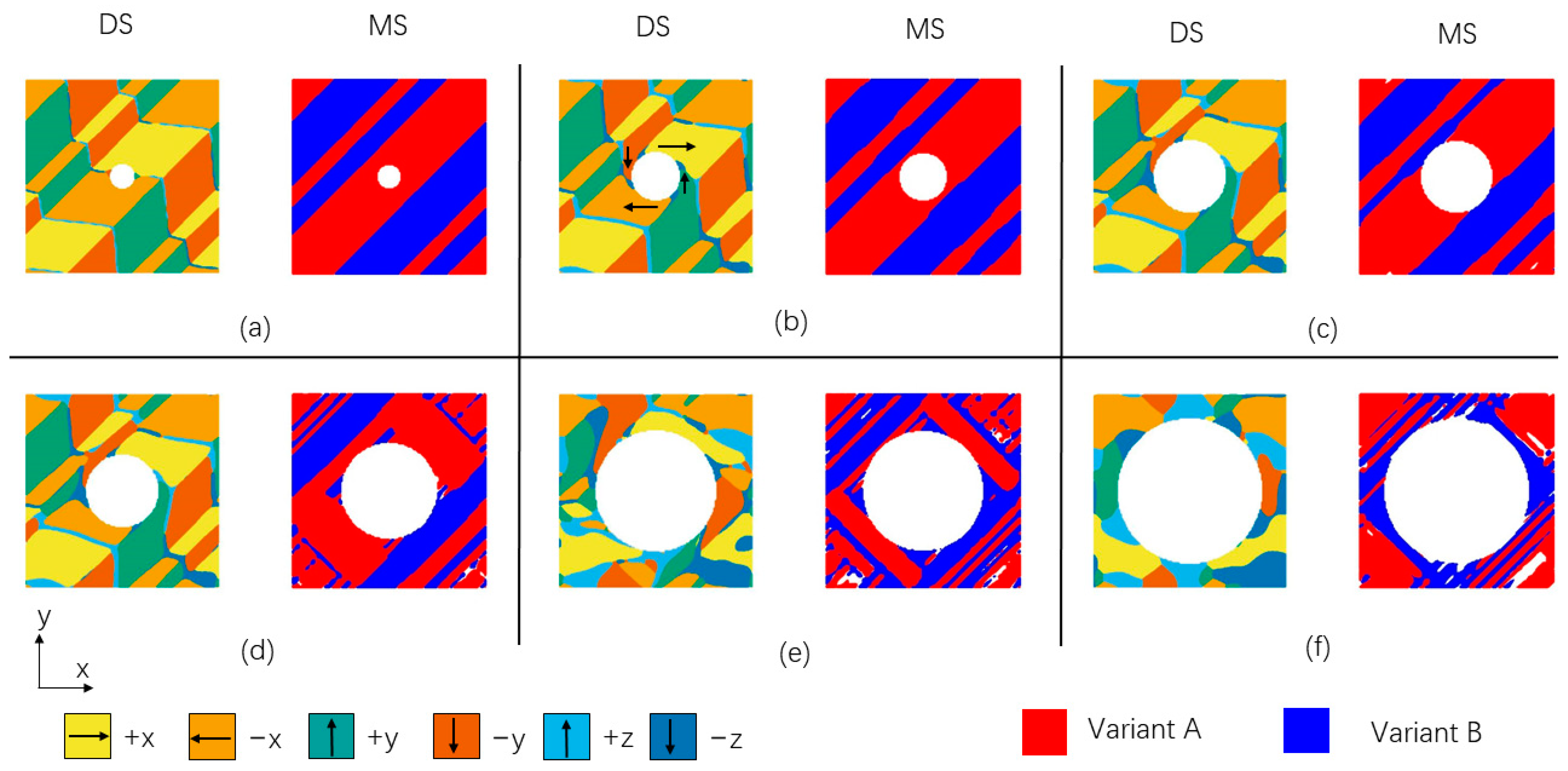
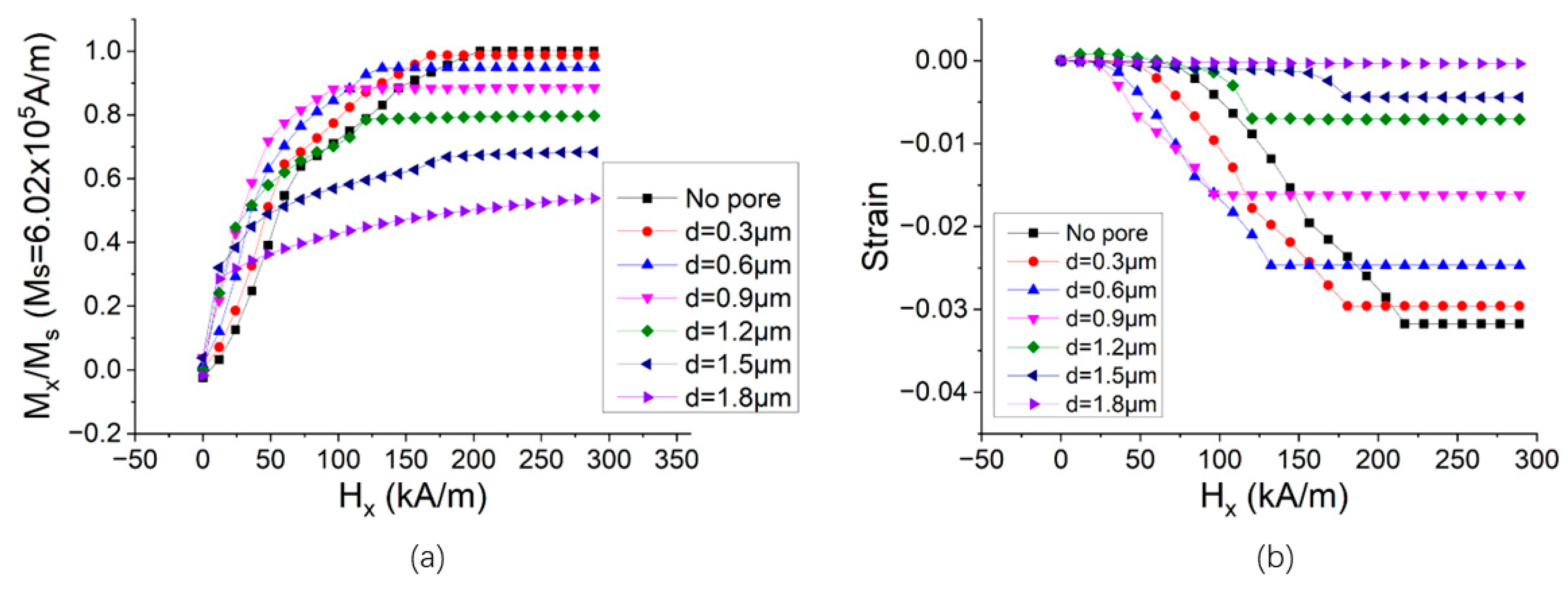
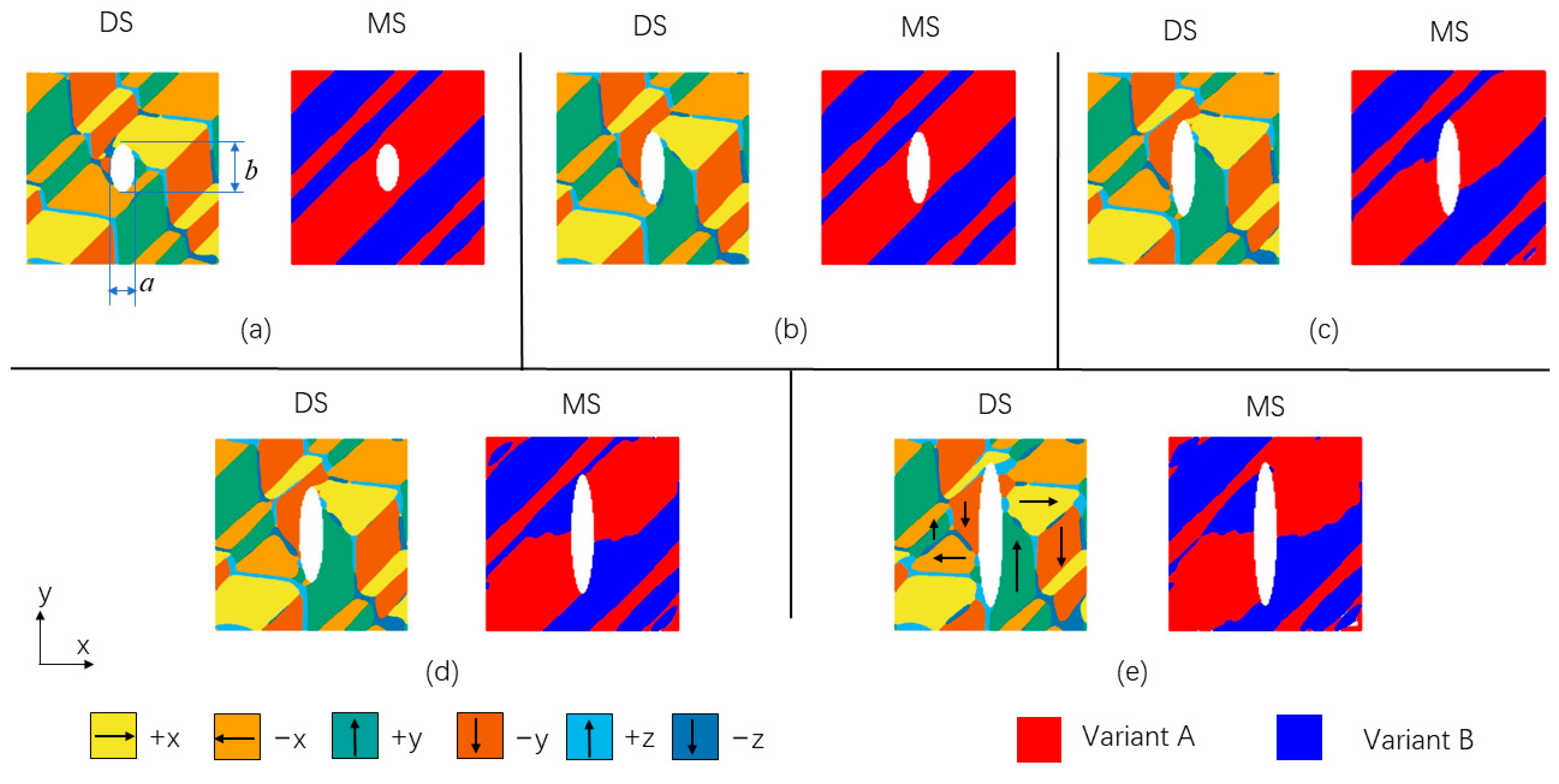

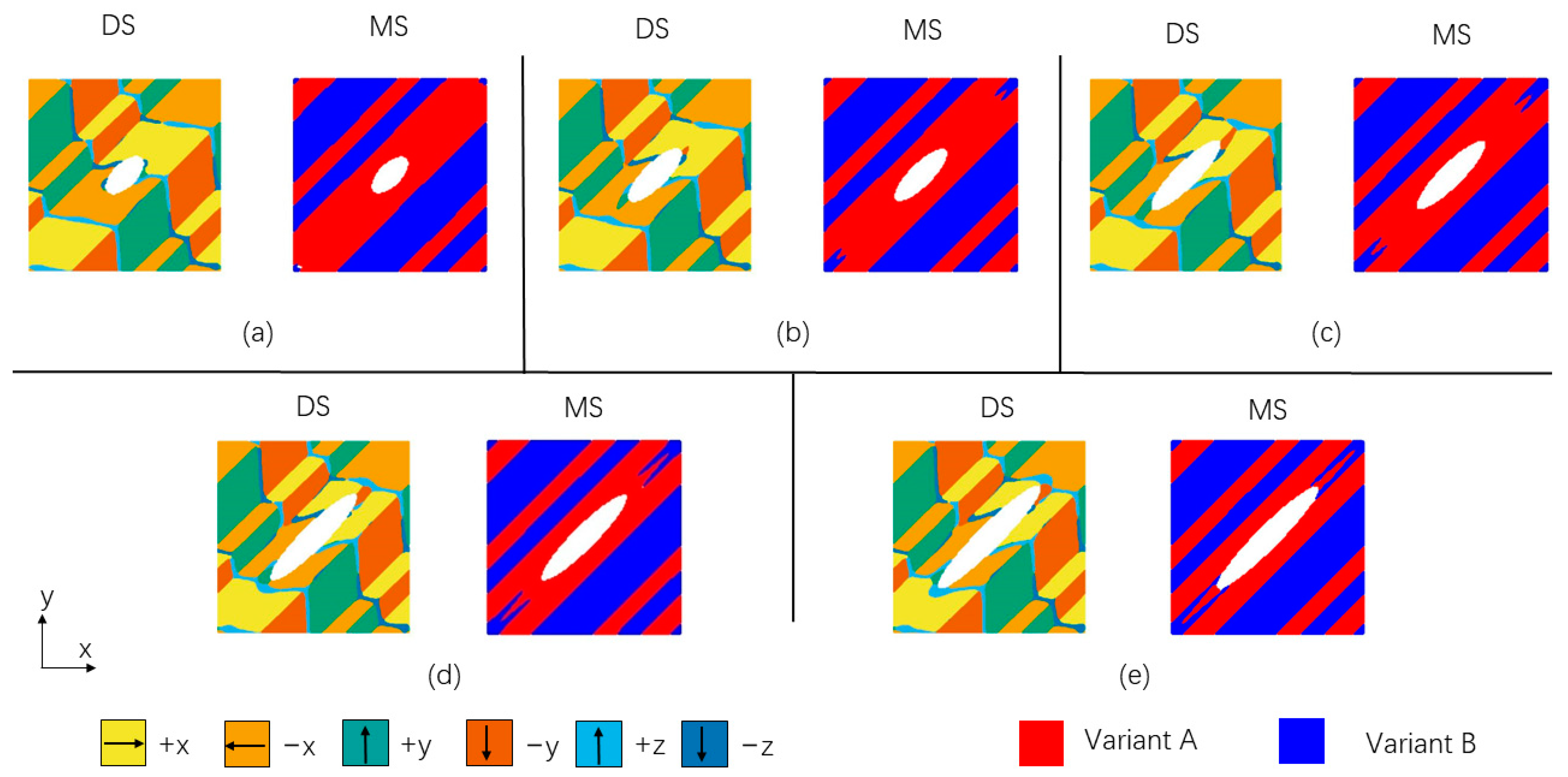
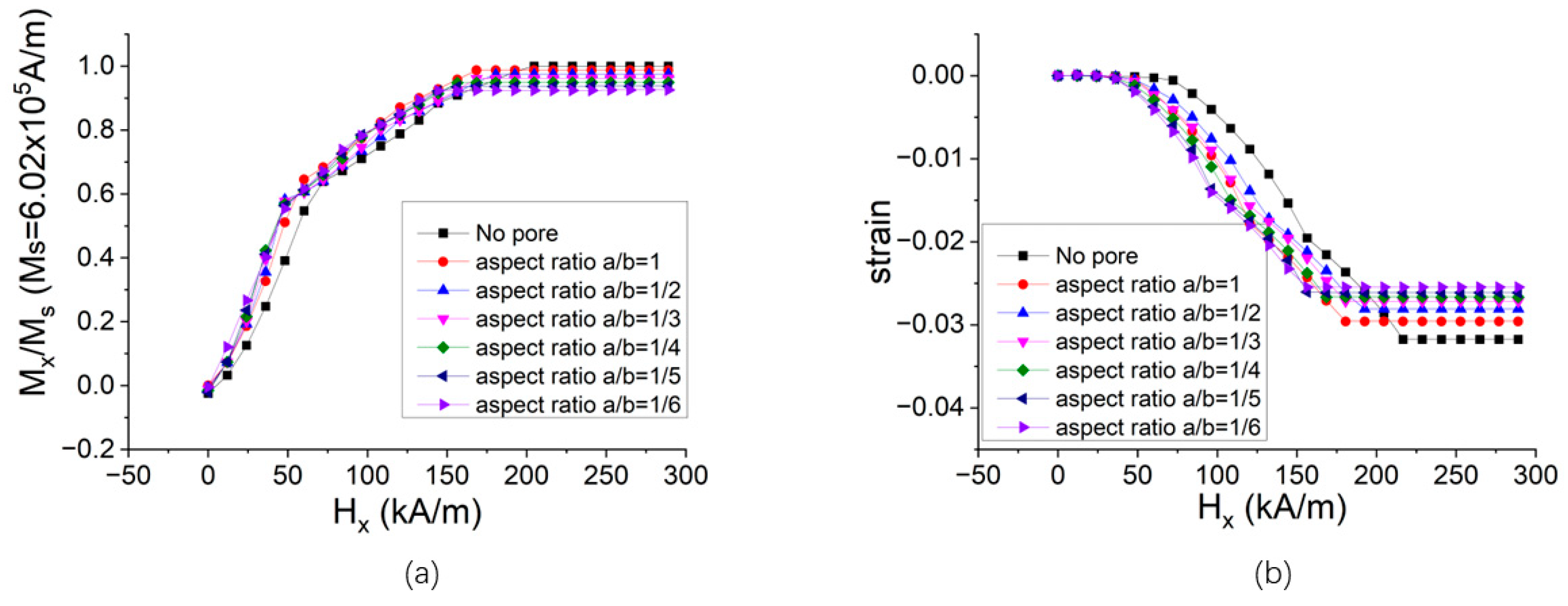



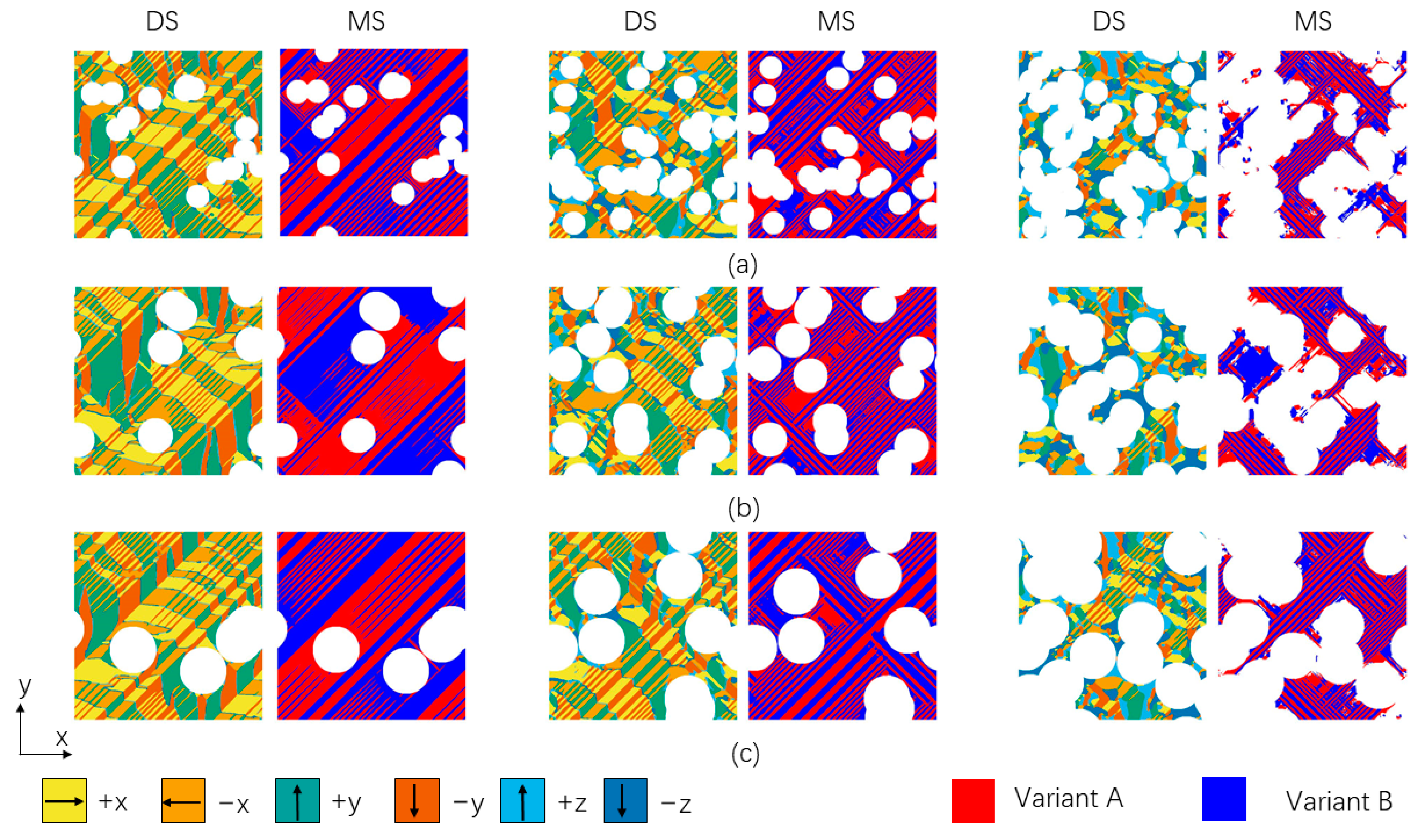
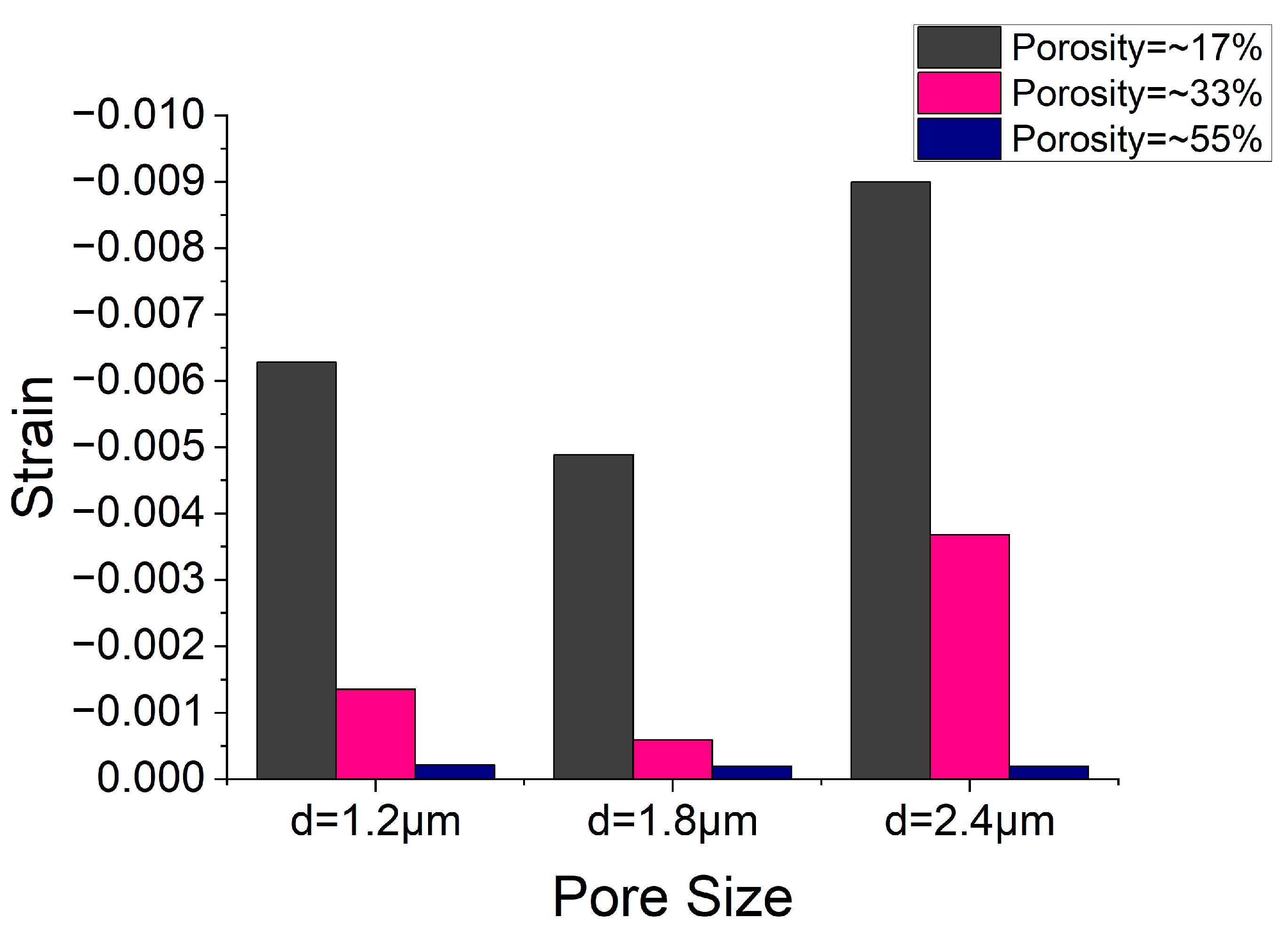
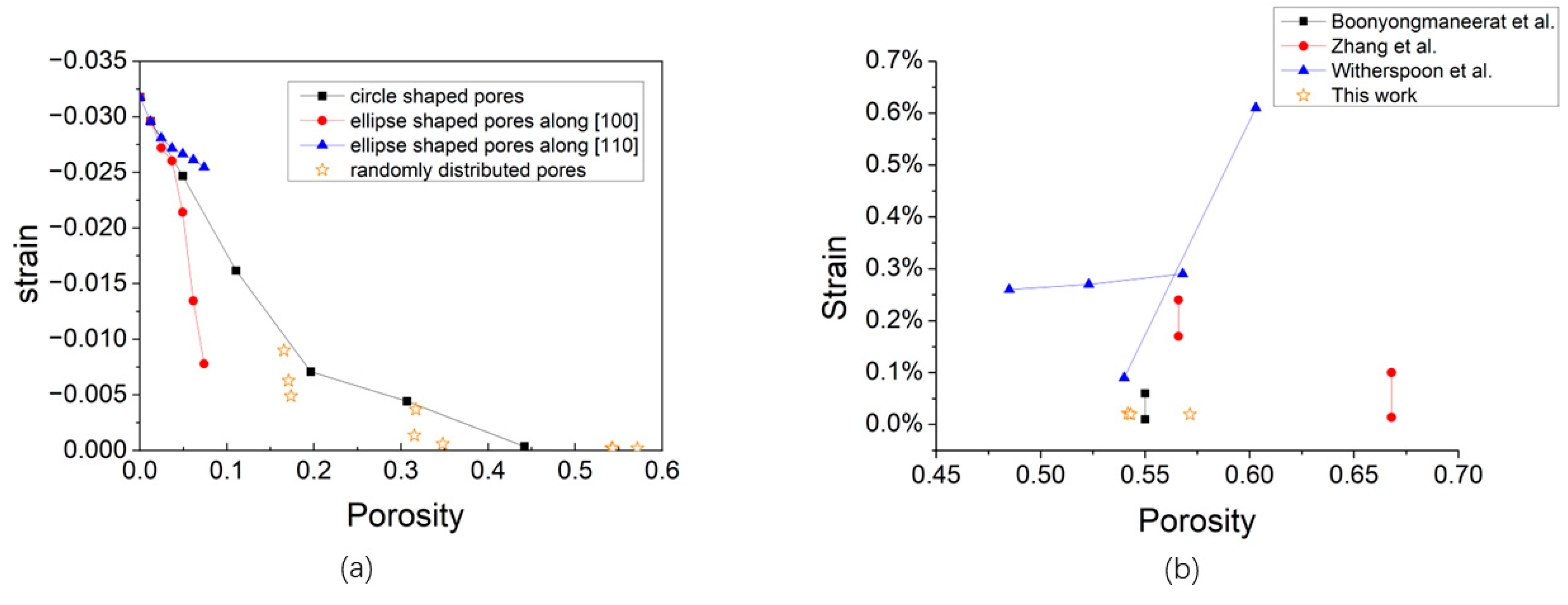
| Symbol | Description | Value | Unit | Ref. |
|---|---|---|---|---|
| μ0 | vacuum permeability | 4π × 10−7 | H/m | |
| Ms | magnetization saturation | 6.02 × 105 | A/m | [32] |
| A | exchange stiffness | 2 × 10−11 | J/m | [33] |
| K1 | anisotropy constant | 2.7 × 103 | J/m3 | [32] |
| K2 | anisotropy constant | −6.1 × 103 | J/m3 | [32] |
| Q1 | bulk energy coefficients | 2.32 × 1011 | J/m3 | [31] |
| Q2 | bulk energy coefficients | 3.78 × 108 × (T−TM)/TM | J/m3 | [31] |
| Q3 | bulk energy coefficients | 0.40 × 1010 | J/m3 | [31] |
| Q4 | bulk energy coefficients | 7.50 × 1010 | J/m3 | [31] |
| g | strain gradient coefficient | 1.0 × 10−8 | J/m | [34] |
| C11 | elastic constant | 1.60 × 1011 | N/m2 | [35] |
| C12 | elastic constant | 1.52 × 1011 | N/m2 | [35] |
| C44 | elastic constant | 0.43 × 1011 | N/m2 | [35] |
| B | magnetoelastic coupling coefficient | 2.00 × 106 | N/m2 | [32] |
| T | temperature | 250 | K | |
| TM | martensite transition temperature | 300 | K | [36] |
Disclaimer/Publisher’s Note: The statements, opinions and data contained in all publications are solely those of the individual author(s) and contributor(s) and not of MDPI and/or the editor(s). MDPI and/or the editor(s) disclaim responsibility for any injury to people or property resulting from any ideas, methods, instructions or products referred to in the content. |
© 2023 by the authors. Licensee MDPI, Basel, Switzerland. This article is an open access article distributed under the terms and conditions of the Creative Commons Attribution (CC BY) license (https://creativecommons.org/licenses/by/4.0/).
Share and Cite
Xu, C.; Huang, Y.; Liang, Y.; Wu, P. Phase Field Simulations of Microstructures in Porous Ferromagnetic Shape Memory Alloy Ni2MnGa. Metals 2023, 13, 1572. https://doi.org/10.3390/met13091572
Xu C, Huang Y, Liang Y, Wu P. Phase Field Simulations of Microstructures in Porous Ferromagnetic Shape Memory Alloy Ni2MnGa. Metals. 2023; 13(9):1572. https://doi.org/10.3390/met13091572
Chicago/Turabian StyleXu, Cailian, Yu Huang, Yongfeng Liang, and Pingping Wu. 2023. "Phase Field Simulations of Microstructures in Porous Ferromagnetic Shape Memory Alloy Ni2MnGa" Metals 13, no. 9: 1572. https://doi.org/10.3390/met13091572






